Porsche by 4 cylinders engine
Note: Specify year is model year!
1.1 - Porsche 924 coupé
 In 1975 (1976 model) the Porsche 924 was launched, replacing the VW/Porsche 914. The development started with the collaboration between VW/Audi and Porsche. However, in connection with the oil crisis in 1973, VW broke out of the partnership in 1975, and left Porsche with the task of promoting the car. The car is inexpensive to produce, using quality components from VW and Audi. The engine used is a 2L Audi engine with 125 HP and Bosch K-Jetronic injection.
In 1975 (1976 model) the Porsche 924 was launched, replacing the VW/Porsche 914. The development started with the collaboration between VW/Audi and Porsche. However, in connection with the oil crisis in 1973, VW broke out of the partnership in 1975, and left Porsche with the task of promoting the car. The car is inexpensive to produce, using quality components from VW and Audi. The engine used is a 2L Audi engine with 125 HP and Bosch K-Jetronic injection.
I have personally seen the Porsche 924 win a race at the Korskro track in the late 70's.
Many people praised the car for its beautiful lines, alltough many thought the capacity of the engine to be a little low for a Porsche.
The exterior design has clearly inspired several Japanese car producers.
Here, I would like to highlight Mazda 323F, more specifically the edition which features the 'Sleepy Eyes' headlights from the 80's. This model can still be seen in Denmark.
1.2 - Porsche 924 turbo coupé (Factory term 931)
In 1978 this edition was being introduced with an increase of 41% to 177 hp
1.3 - Porsche 924 note
Porsche 924 was produced at Audi's factory in Neckarsulm. During the 12 years that Porsche 924 was on the market, 150.684 cars was produced. The last cars of this model produced, came with a Porsche 944 engine.
2.0.1 - Porsche 944 engine
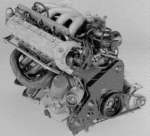 As the Porsche 924 was based on a 2,0L Audi engine, the Porsche engineers had no particular interest in further developing it. Besides, it was a little sad to open the hood of a Porsche, just to find the name Audi on the top piece (one can always be glad it didn't say LADA). As the Porsche 924 was based on a 2,0L Audi engine, the Porsche engineers had no particular interest in further developing it. Besides, it was a little sad to open the hood of a Porsche, just to find the name Audi on the top piece (one can always be glad it didn't say LADA).
The Porsche factory tried to find a suitable engine, and among other options was a V6 Volvo/Renault engine. The factory also considered developing a new 6 cylinder engine, but an engine space designed to fit a 4 cylinder Audi engine was too small for that.
Based on the newly developed V8 Porsche 928 engine (1978), a 4 cylinder water-cooled inline engine was produced. To maximize the performance , the drilling was raised to 100 mm. This resulted in a raw but unstable oversquare engine. The lack of stability was resolved by using the Mitsubishi patented invention of two opposite rotating balancing axles.
This resulted in a 2479 ccm and 163 HP engine with incredible features. For instance, on flat terrain you will be able to start the car in 2nd gear without problems.
In 1987, to demonstrate the endurance of a standard 944 engine, a car was driven 500.000 kilometers over a period of 12 months. The engine passed the test without any problems.
2.0.2 - Porsche 944 body
Having the perfect 51:49 weight balance, the Porsche 924 Carrera GT body was used as a starting point as adjustment were made to fit the new engine.
Porsche 924 was 1,69 cm wide. By extending the tender by 3 cm, to total width was now 1,75 cm. This allowed for the use of tires up to 225 mm wide.
Hereby said that many body parts from Porsche 924 actually fits a Porsche 944. I was told that a fresh-out-of-the-store Porsche 944 real tender cost 28.000 kr. plus montage and paint, which is a bit more expensive than a similar tendet for instance for a Fiat 127.
2.1 - Porsche 944 coupé (Early)
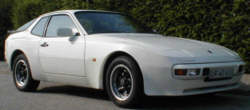 In September 1981 the first Porsche 944 was launched at a Frankfurt auto exhibition (1982 model). It had the same interior as Porsche 924. This design is called Early. In 1982 the car also became available on the market in the country some like to call "God's own country". The american version of this model only featured 150 hp. They are sure lacking behind over there *lol*.
In September 1981 the first Porsche 944 was launched at a Frankfurt auto exhibition (1982 model). It had the same interior as Porsche 924. This design is called Early. In 1982 the car also became available on the market in the country some like to call "God's own country". The american version of this model only featured 150 hp. They are sure lacking behind over there *lol*.
The car was standard equipped with 15 inch Cookie cutter rims (looks like Fuchs rims from a distance), and 185 mm tires.
 In 1983 the car made it to the American
In 1983 the car made it to the American
Car and Driver 10 Best list, and stayed there until 1986.so the overall impression of the car must have been good. |
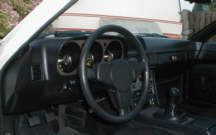 |
2.2.1 - Porsche 944 coupé (Late)
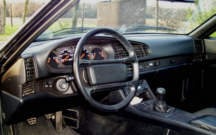 |
In the middle of 1985 the car gets a new interior. The square outline of the interior from Porsche 924 was replaced with a more curvy shape, making it easier to clean. This shape continues in most cars until the mid 90's (my Hilux from 92 and the replacementfrom 99 has this interior outline). from 99 has this interior outline). from 99 has this interior outline).
At the same time, the outer appearance also gets spiffed with the Phone-dial rims, similar to the ones on Porsche 928.
The standard model was produced until 1989, and was the last year equipped with an 8 valve, 2681 ccm engine. This model has a drilling of 104 mm, but only 165 hp.
|
The models from 1985 comes with a catalyst, and can therefore run on unleaded gasoline. The capacity of the tank is increased to 80 liters.
2.2.2 - Porsche 944 turbo coupé (Factory term 951)
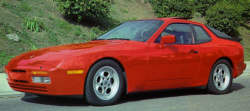 |
At the same time as the new interior is introduced in '85, the turbo charger is also introduced and added to the car. Performance is increased by 32% to 220 hp, resulting in a top speed of 245 km/h.
The car gets a new front and a stabilizing shield in the rear.
This fresh turbo look is more aerodynamic!
|
2.3 - Porsche 944S coupé & Porsche 944 Turbo S coupé
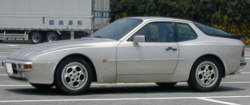 The 'S' signifies Porsche's development of the engine to an edition with 16 valves. The volume of 2479 ccm is still the same, but the performance is increased to 190 hp. This model had ABS brakes.
The 'S' signifies Porsche's development of the engine to an edition with 16 valves. The volume of 2479 ccm is still the same, but the performance is increased to 190 hp. This model had ABS brakes.
A year later, in 1988, the turbo S model with 250 hp was launched. The top speed is 260 km/h. All turbo models features 8 valves.
2.4 - Porsche 944 S2 coupé
 In 1989 Porsche 944 S2 was launched, with a strongly improved 16 valve engine. By increasing the bore and stroke, the engine was now a 3.0L with a performance capacity of 211 hp. So far, this is the worlds largest serialproduced 4 cylinder inline engine without turbo. It gives the car a top speed of 240 km/h. Starting in 1989, the Design 90 rim is used.
In 1989 Porsche 944 S2 was launched, with a strongly improved 16 valve engine. By increasing the bore and stroke, the engine was now a 3.0L with a performance capacity of 211 hp. So far, this is the worlds largest serialproduced 4 cylinder inline engine without turbo. It gives the car a top speed of 240 km/h. Starting in 1989, the Design 90 rim is used.
For Porsche 944 S2, the more aerodynamic turbo body is used.
2.5 - Porsche 944 S2 convertible & Porsche 944 Turbo S convertible
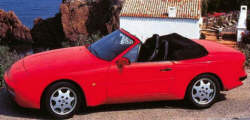 We have now made it to the last model in the Porsche 944 series.
We have now made it to the last model in the Porsche 944 series.
Here too, the turbo body is the basic element. The mild curve between rear tire, back window and real hood is no longer visible, but overall it was a smart sports car, and the convertible became very popular. The car has a top speed of 240 and 260 km/h.
2.6 - Porsche 944 note
Porsche 944 was in production for 10 years. The body was made at Audi in Neckarsulm, and the engine was manufactured at the Porsche factory in Zuffenhausen. The official production number from Porsche is 163.302, which makes this model the absolute best-selling at Porsche. Porsche 944 Targa does not really exist.
This because the definition of a Targa is, that the roof between the windshield and the rear window is removed. This means that the side-door window does not close against the steady frame of a roof-top. None of the cars I have seen fits that description! Although, there do exist some models with enlarged sunroof, most of them automatic. And there are some modified editions in Germany, which are called Cab/Targa.
The Porsche club news page states, that the total number of cars produced in the 924-944-968 series is 325.231.
The model with stearing wheel placed in the right side, has factory number 945.
3.1 - Porsche 968 coupé & Porsche 968 convertible
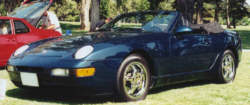 Porsche 968 is without a doubt the top model of the 4 cylinder models.
Porsche 968 is without a doubt the top model of the 4 cylinder models.
The front of the body has the same look as Porsche 911, and the rear is definitely inspired by Porsche 928. The S2 engine was tuned and now performed with 240 hp, and a new gearbox featuring 6 gears was fitted. As extra equipment, the affordable Tiptronic automatic gearshift could be added.
Both coupé and convertible could manage a top speed of 252 km/h, and 0-100 km/h in 6,5 sec.
3.2 - Porsche 968 turbo S coupé
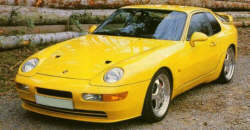 In 1993 the 3.0L engine with turbo charger was launched. The engine code is M44/60, so it's a 944 engine without doubt.
In 1993 the 3.0L engine with turbo charger was launched. The engine code is M44/60, so it's a 944 engine without doubt.
The engine performs with 305 hp at 5400 rotations which results in a top speed of 280 km/h, and 0-100 km/h in 5 seconds.
During the 2 years Porsche 968 was in the market, only 14 was assembled.
3.3 - Porsche 968 note
In the period of 1992-1995 over 11.000 cars were assembled, out of which approx. 1/3 were convertibles.
In 1996 all production of cars with M44 engines is stopped. This makes room for Porsche 986 Boxster, which comes with a centered 6 cylinder, water-cooled engine.
Translated by: Anja Joergensen
Source to this page:
MLA
Porsche
Porsche Centrum
Austro Classic
Cantonia
Nice
|
 |
|
Back to
The Garage
Die Werkstatt
Værkstedet
|
|
|
|